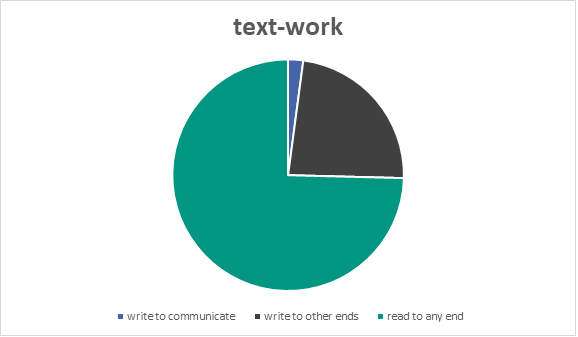Write the Research No. 1
Why write?
You're probably thinking, "To publish." Or maybe, "To reach others with my work." And I certainly do agree with you there, because, yes indeed, you do write to reach others by publishing your work.
But what if I told you that this one purpose of the writing for research purposes — let's call it, writing to communicate — what if this purpose was just one among the very many purposes a researcher can have for his or her text-work in the research? Because yes, actually, that is just what I am telling you. Writing to communicate is merely one single purpose for using text in the research.
Okay, just to put this whole thing in perspective here, let's say that all the writing you do on any project is very much less than half of the text-work you'll do in order to complete the project. (That other bigger portion is your reading to research — but that's the focus of my posts on Read the Research.) So, just to make a point, I'll claim that, of all the text-work you do on any project, only some 25% will be in the act of writing. Now, it is a fact that only a small fraction of that 25% will be the writing you do to communicate. I can't say just how small — I mean, there are no measurement studies on the matter — but I will say that I feel comfortable claiming this:
Your writing to communicate in any given project will not amount to more than 5% of the total writing you do for that project.
The proportions I am talking about, then, will look very much something like this:

Now, I'm sure this will come as some surprise, and it's even quite possible that you are heavily disagreeing with the above depiction. But get this.
You are writing also when you take notes on your reading, when you outline a manuscript, when you correspond with coauthors, when you correspond with non-coauthors, when you code, when you sketch on a whiteboard or on a tablet, when you enter search terms into a browser or database, when you jot ideas, when you jot to-do lists, when you jot in the margins, when you jot on the back of an envelope...
Now, let me tell you, I don't often use the convention of three dots to indicate OPEN-END, because in actual fact, I hate the convention. But in this case here, I really have no choice. The number of possible uses that the writing might be put to during a project truly are endless, or at least as varied as there are researchers and projects to be putting the writing to use for — so, as I say, endless.
A researcher can write to demonstrate the relevance of other work, a researcher can write to weigh up one technique against another, a researcher can write to prepare for an upcoming presentation about the project, a researcher can write to remember to check the literature on some idea, a researcher can write to formulate a hypothesis, a researcher can write to x — where x equals any purpose a researcher might possibly pursue on a project by means of text, apart from that one single purpose of finalizing all the thinking and the coding and the experimenting and the interpreting so as to achieve a submittable version of the project in the form of a correctly formatted manuscript for venue A or venue B or venue C. Because really, this last, this finalizing of a manuscript — this is what it means to write to communicate. It's basically just, Get the research into a publicly available form so that editors can publish it and so that other researchers can cite it.
So, by this count, the writing to communicate is really the tail-end writing on a project. All the drafting, and very much of the revising too, do not pass as writing to communicate. Just think, as for the writing which any researcher will typically associate with the writing they do for research purposes, pretty much none of that is actually the writing to communicate. Nope. And this is the case because really the great bulk of a researcher's writing efforts is laid on the task of thinking through the ideas of the project and thinking these clearly enough to understand the ideas. That, My Friends, is about as distant as a writer can get from writing to communicate. That drafting sort of writing and that revising sort of writing is really nothing other than researching by means of text. Writing to communicate, on the other hand, is the activity of adjusting one's own understanding to other people's understanding. Writing to communicate is, no doubt, vital to the success of every manuscript; however, since writing to communicate builds on a great big broad base of writing to draft and writing to revise — since that is the truth, well then, writing to communicate will never be a researcher's main job in the writing.
Therefore I tell you, You use the writing right when you keep aware of just what you're using the writing for. Give the writing its due place in your research text-work. Expect of it a lot, because you're doing a lot of it. Because, if you reduce your purpose for writing down to just writing to communicate, well by doing that to yourself, you would be reducing the myriad of purposes which writing may help you to fulfil down to a mere single measly one.
Why write like that? Better write to ______ . [Fill in blank according to purpose.]
Please email comments or questions to daniel.shea∂kit.edu
This blog is for you.

